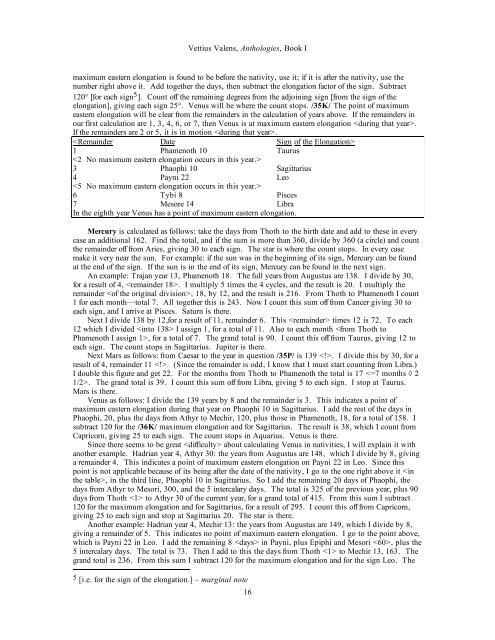Vettius Valens, Anthologies
Vettius Valens, Anthologies
Vettius Valens, Anthologies
Create successful ePaper yourself
Turn your PDF publications into a flip-book with our unique Google optimized e-Paper software.
<strong>Vettius</strong> <strong>Valens</strong>, <strong>Anthologies</strong>, Book I<br />
maximum eastern elongation is found to be before the nativity, use it; if it is after the nativity, use the<br />
number right above it. Add together the days, then subtract the elongation factor of the sign. Subtract<br />
120° [for each sign 5 ]. Count off the remaining degrees from the adjoining sign [from the sign of the<br />
elongation], giving each sign 25°. Venus will be where the count stops. /35K/ The point of maximum<br />
eastern elongation will be clear from the remainders in the calculation of years above. If the remainders in<br />
our first calculation are 1, 3, 4, 6, or 7, then Venus is at maximum eastern elongation .<br />
If the remainders are 2 or 5, it is in motion .<br />
<br />
1 Phamenoth 10 Taurus<br />
<br />
3 Phaophi 10 Sagittarius<br />
4 Payni 22 Leo<br />
<br />
6 Tybi 8 Pisces<br />
7 Mesore 14 Libra<br />
In the eighth year Venus has a point of maximum eastern elongation.<br />
Mercury is calculated as follows: take the days from Thoth to the birth date and add to these in every<br />
case an additional 162. Find the total, and if the sum is more than 360, divide by 360 (a circle) and count<br />
the remainder off from Aries, giving 30 to each sign. The star is where the count stops. In every case<br />
make it very near the sun. For example: if the sun was in the beginning of its sign, Mercury can be found<br />
at the end of the sign. If the sun is in the end of its sign, Mercury can be found in the next sign.<br />
An example: Trajan year 13, Phamenoth 18. The full years from Augustus are 138. I divide by 30,<br />
for a result of 4, . I multiply 5 times the 4 cycles, and the result is 20. I multiply the<br />
remainder , 18, by 12, and the result is 216. From Thoth to Phamenoth I count<br />
1 for each month—total 7. All together this is 243. Now I count this sum off from Cancer giving 30 to<br />
each sign, and I arrive at Pisces. Saturn is there.<br />
Next I divide 138 by 12,for a result of 11, remainder 6. This times 12 is 72. To each<br />
12 which I divided I assign 1, for a total of 11. Also to each month , for a total of 7. The grand total is 90. I count this off from Taurus, giving 12 to<br />
each sign. The count stops in Sagittarius. Jupiter is there.<br />
Next Mars as follows: from Caesar to the year in question /35P/ is 139 . I divide this by 30, for a<br />
result of 4, remainder 11 . (Since the remainder is odd, I know that I must start counting from Libra.)<br />
I double this figure and get 22. For the months from Thoth to Phamenoth the total is 17 . The grand total is 39. I count this sum off from Libra, giving 5 to each sign. I stop at Taurus.<br />
Mars is there.<br />
Venus as follows: I divide the 139 years by 8 and the remainder is 3. This indicates a point of<br />
maximum eastern elongation during that year on Phaophi 10 in Sagittarius. I add the rest of the days in<br />
Phaophi, 20, plus the days from Athyr to Mechir, 120, plus those in Phamenoth, 18, for a total of 158. I<br />
subtract 120 for the /36K/ maximum elongation and for Sagittarius. The result is 38, which I count from<br />
Capricorn, giving 25 to each sign. The count stops in Aquarius. Venus is there.<br />
Since there seems to be great about calculating Venus in nativities, I will explain it with<br />
another example. Hadrian year 4, Athyr 30: the years from Augustus are 148, which I divide by 8, giving<br />
a remainder 4. This indicates a point of maximum eastern elongation on Payni 22 in Leo. Since this<br />
point is not applicable because of its being after the date of the nativity, I go to the one right above it , in the third line, Phaophi 10 in Sagittarius. So I add the remaining 20 days of Phaophi, the<br />
days from Athyr to Mesori, 300, and the 5 intercalary days. The total is 325 of the previous year, plus 90<br />
days from Thoth to Athyr 30 of the current year, for a grand total of 415. From this sum I subtract<br />
120 for the maximum elongation and for Sagittarius, for a result of 295. I count this off from Capricorn,<br />
giving 25 to each sign and stop at Sagittarius 20. The star is there.<br />
Another example: Hadrian year 4, Mechir 13: the years from Augustus are 149, which I divide by 8,<br />
giving a remainder of 5. This indicates no point of maximum eastern elongation. I go to the point above,<br />
which is Payni 22 in Leo. I add the remaining 8 in Payni, plus Epiphi and Mesori , plus the<br />
5 intercalary days. The total is 73. Then I add to this the days from Thoth to Mechir 13, 163. The<br />
grand total is 236. From this sum I subtract 120 for the maximum elongation and for the sign Leo. The<br />
5 [i.e. for the sign of the elongation.] – marginal note<br />
16

















